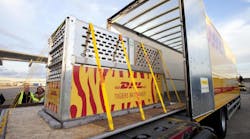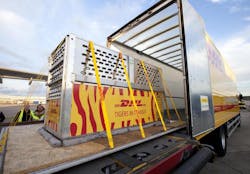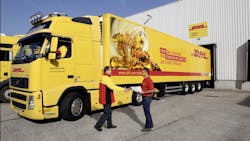You may recall the Tom Hanks movie “Castaway” back in 2000, which told the story of a FedEx supervisor stranded on a deserted Pacific island for four years following a terrible airplane crash.
One of the movie’s early scenes finds Hanks’ character, Chuck Noland, sorting through all of these FedEx packages and parcels washing up on the beach; a plethora of odds and ends, such as divorce papers, video tapes, ice skates (which he actually puts to good use) plus a lonely volleyball that almost by accident becomes his sidekick.
What I found most interesting about this particular scene is how the transportation of such random stuff is a given such short shrift in modern life. We no more think about the intricacies of sending a volleyball halfway around the world than we do about brushing our teeth. We just brush, spit, rinse, and then move on to the next thing.
Like I noted in my post yesterday, modern life rests squarely on a global transportation system that’s largely taken for granted – one most folks don’t even contemplate unless suddenly thrust into an extreme situation like the one in “Castaway.”
DHL Express recently shed some more much-needed light on this subject by listing just a few of the “unusual” and “non-traditional” shipments it handled in 2014. For example:
- In August 2014, South African pole vaulting athlete Cheyne Rahme realized he could not check-in his six meter long pole on his flight to Morocco for the 19th Africa Senior Championships – just four days before he was set to compete. DHL managed to deliver the pole to the competition venue – with just a few hours to spare before Rahme competed and he went on to win a gold medal.
- One DHL client based in East Africa arranged for weekly deliveries – yes WEEKLY – of curry from his favorite local restaurant in Europe.
- DHL also transported two giant pandas over 8,000 kilometers (some 4,971 miles) from China to Belgium last year in a dedicated Boeing 767 freighter aircraft. The female, Hao Hao, and the male, Xing Hui, both aged four, were accompanied by a team of handlers and veterinarians plus 220 pounds of bamboo to snack upon.
Further, back in 2012, DHL handled transport for Melati, a female tiger from Perth Zoo in Australia, and Jae-Jae – a male tiger from the Akron Zoo in Ohio – to the London Zoo.
DHL shipped both beasts in special cages equipped with infrared cameras to allow each tiger's on-board keeper to monitor their well-being throughout the journey – along with two gallons of water and 10 pounds of raw beef for their in-flight meals.
Of course, as everyone in trucking knows, handling such a wide range of deliveries – especially zoo animals – is anything but easy.
And John Pearson, CEO of DHL Express Europe, recently noted in a blog post how those and other demands being placed more and more frequently on the backs of global transport providers will require what he calls ”incremental innovation” to continue being successful and free of glitches.
“With drones, driverless vehicles and 3D printing making the headlines in mainstream international media, however, and firing the imagination of budding transport entrepreneurs and customers alike, logistics has recently been enjoying some of the ‘corporate rock star’ media attention typically reserved for Google, Amazon and other pioneers of disruptive innovation,” he explained. “Those technologies, coming alongside the advent of online shopping, have the potential to revolutionize logistics and global trade in the coming years.”Yet at the same time, Pearson (at left) stressed that a variety of challenges – both commercial and regulatory - remain to some of those more "ambitious technologies," which may push their prospects for broader international adoption back to the mid-term.
“In the near-term, then, logistics companies will continue to slug it out on a more conventional and increasingly competitive battlefield of trucks, ships, trains, planes and, of course, metal boxes,” he said.
“Technology, such as customer apps, electronic documentation, scanning systems and data analysis, will continue to play an important supporting role,” Pearson added.
Yet this is where incremental and innovative changes “at the margins” come into play.
“In the ’80s, we could still establish a competitive advantage by opening up new emerging markets for express delivery services,” he noted. “In the ’90s, we could ride on the back of the Internet’s global expansion to introduce tracking services that gave customers unprecedented visibility on their shipments –and give us even better control of the shipping process.”In the ’00s, Person noted, transport providers like DHL could introduce bigger, more efficient freighter aircraft with even longer ranges and higher payloads to connect the major intercontinental trade lanes even quicker.
“Yet in the ’10s, it’s become more difficult than ever to achieve quality leadership within our industry,” he stressed. “This has meant that our efforts to keep ourselves apart from the competition have become more incremental and more closely focused on a number of areas – in particular, customer service [by] instilling a customer-centric culture in an industry where customers still talk every day to employees, targeted but impactful changes to our network that shave crucial minutes or (where possible) hours off the transit time and a tailored focus on the sectors that need express services most.”
In Pearson’s view, standing out in extremely competitive markets will continue to require unconventional, outside-the-box ideas. “Companies that make simple but innovative changes at the margins can carve out a competitive advantage of their own,” he pointed out.
Yet such “simple” changes will no doubt generate big ripple effects in the freight world. It will be interesting to see, then, what occurs.






